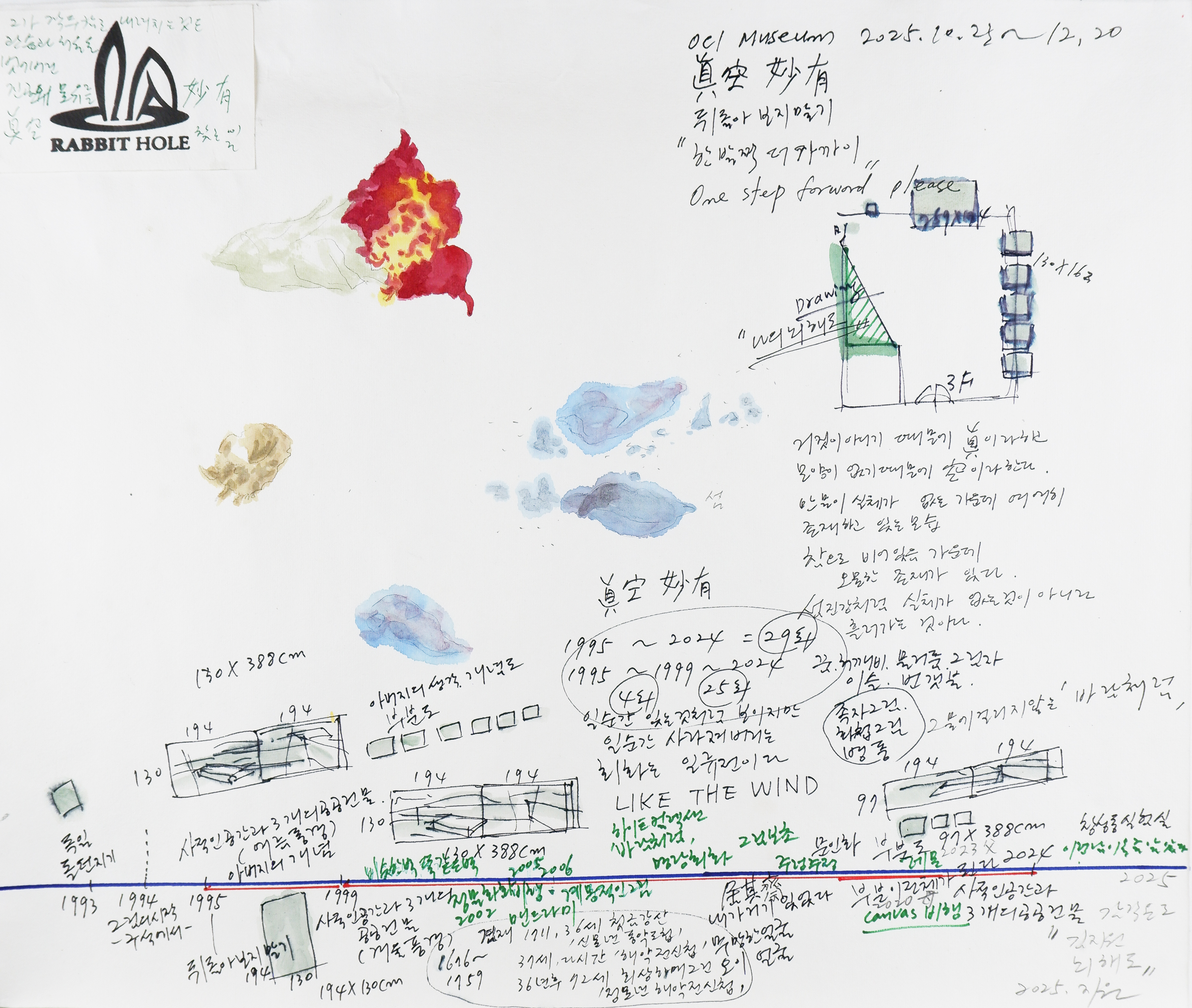여행
2023. 11. 16 - 2024. 2. 4 | [VISIT] SpaceK Seoul
유이치 히라코

코오롱의 문화예술 나눔공간 ‘스페이스K 서울’(강서구 마곡동 소재)은 오는 11월 16일부터 내년 2월 4일까지 도쿄를 중심으로 국제적 활동을 이어가는 일본 작가 유이치 히라코 (b.1982, Yuichi Hirako)의 개인전을 개최한다. <여행>이란 제목으로 열리는 이번 전시는 작가의 회화, 조각, 설치 등 다양한 장르를 넘나드는 작품 30여 점이 소개된다. 유이치 히라코는 그간 자연과 인간의 관계에 중점을 두고 동식물이 함께하는 풍경들을 소개해 왔다. 이를 통해 인간과 자연의 공존을 추구하며 나아가 우리가 자연을 바라보는 인식의 전환을 유도한다.

Yuichi Hirako Profile, Courtesy of Space K Seoul
일본 오카야마에서 태어난 유이치 히라코는 영국 런던의 윔블던 예술 대학을 졸업하고 현재 일본 도쿄를 중심으로 국제적 활동을 펼치고 있다. 2022년 도쿄 네리마 구립 미술관(Nerima Art Museum) 등에서 개인전을 열었고 2021년 상하이 파워롱미술관(Powerlong Museum), 2019년 사쿠라 시립 미술관(Sakura City Museum of Art)과 2013년 도쿄 도쿄도 미술관(Tokyo Metropolitan Art Museum) 등에서 열린 단체전에 참여했다. 2013년 일본 신진 예술가를 위한 VOCA상을 수상한 바 있다. 상하이 파워롱미술관(Powerlong Museum)과 스위스 장 피고치 컬렉션(Jean Pigozzi Collection) 등에 작품이 소장되었다.
작가의 작품에는 동식물이 많이 등장한다. 이는 풍부한 자연환경이 장점인 오카야마에서 어린 시절을 보낸 작가의 경험이 예술관 형성에 주요했다. 곤충채집과 낚시를 즐기며 자연과 함께했던 추억이 긍정적으로 작용한 셈이다. 이후 작가는 도시 환경에서 자연의 역할에 주목한다. 계기는 유학 시절 대도시인 런던에서 머물렀던 경험이 컸다. 이때 작가는 도시 녹지 즉, 가로수나 공원 등 특정 구획에 인위적으로 자리한 자연에 대해 의구심을 가졌다. 사람들이 심리적 위안을 얻기 위해 찾는 자연이 인간의 돌봄이 없으면 유지될 수 없는 인공의 자연이라고 인식했기 때문이다. 작가는 환경과 관련된 다양한 사회적 이슈 또한 자연을 대하는 인간 중심의 태도부터 바뀌어야 한다고 봤다. 따라서 보다 동등한 위치에서 인간과 자연을 바라보고자 한다. 때문에 작가의 화면은 다양한 동식물들이 인간 형상의 나무와 함께 배치하는 구성으로 발전한다.

Memories of My Garden / A march, 2010, acrylic on canvas, 130.5 x 162.4cm
작가가 상상하는 정원인 <Memories of My Garden / A march, 2010>은 앞서 이야기한 작가가 자연을 생각하는 태도가 잘 담겨있다. 작가의 정원에는 우리가 제단하고 가꾸는 정원이 아니라 자연 그대로의 모습이 초현실적으로 묘사된다. 화면엔 다소 음습한 숲의 풍경이 펼쳐지고 나무 머리를 한 인간이 숲을 배회한다. 그림을 자세히 관찰하면 인간처럼 보이는 식물과 나무들이 곳곳에 배치된다. 얼핏 보면 나뭇잎처럼 보이는 그들은 바지를 입고 있거나 셔츠와 넥타이 차림새이기도 하고 작은 요정처럼 보이기도 한다. 모두 인간과 식물이 유기적으로 결합된 형태다.
작가는 화면에 매번 특정한 캐릭터를 등장시킨다. 이 캐릭터는 작가가 일본 민속 설화의 나무 정령을 참고해 탄생시킨 것으로 사람의 몸에 나무 머리가 특징이다. 작가는 이 혼종의 인물이 자신의 자화상이자 자연과 관계를 맺고 있는 모든 사람의 초상이라고 말한다. 결국 이 캐릭터는 인간과 자연을 잇는 매개체인 셈인데 이번 전시에서는 강아지, 고양이 그리고 다양한 식물들과 일상을 함께하는 여정을 펼친다. 때로는 강가에서, 때로는 숲속에서, 때로는 방 안에서 동식물과 어우러지는 장면을 연출하며 회화, 조각, 설치 등 다양한 매체로 변주, 관객에게 자연에 대한 감각적 이해도를 높이고자 한다.

Traveling Plants, 2023, acrylic on canvas, 333.3 x 994 cm
이번 전시에서 혼종의 캐릭터는 여러 식물들과 어우러지는 여행을 떠난다. <The Journey(Traveling Plants), 2023>은 길이가 10m에 이르고 높이 3m가 넘는 대작 회화이다. 4개의 각기 다른 화면으로 구성된 이 작품 속 캐릭터 또한 숲, 어딘가 위치한다. 두 혼종의 인물은 형형색색의 씨앗처럼 보이는 대상들 사이에 자리하기도 하고 다른 화면에선 꽃과 식물과 함께 별빛 아래 휴식을 즐기기도 한다. 한편, 새들은 나무 위에 가지런히 앉아 어딘가를 응시한다. 서로 다른 형식의 회화가 4개 화폭으로 이뤄진 이 작품은 각각 구성을 달리하지만 서로의 색채를 공유하며 연결된다. 때문에 이 작품은 파편적이면서도 공존하듯 내러티브를 이어간다. 씨앗이 경계를 넘어 서로 다른 자연에 뿌리를 내려 번성하고 이것은 마치 캠핑과 같은 여행으로 은유된다. 그리고 그 여행을 조력하는 새들 역시 함께한다.

Wooden Wood 49, 2023, acrylic on wood, 345 x 830 x 250 cm
<Wooden Wood 49, 2023>에서 다양한 식물들의 열매가 작가의 캐릭터와 함께 설치되었다. 3m가 넘는 거대한 혼종의 인물들은 나무 조각으로 제작되어 질감이 두드러진다. 원색이 강조되는 열매들 또한 주변으로 배치되어 마치 캐릭터들이 수집한 것과 같은 상황을 연출한다. 입체로 등장하는 작가의 캐릭터들은 이제 평면을 벗어나 현실과의 간극을 줄인다. 작가는 자신의 작품이 동화나 먼 세상의 이야기로만 느껴지지 않도록 조각을 제작했다고 한다. 차원을 넘나들었을 때 관객이 느끼는 대상의 감각을 실험하는 것이다.

<-Green Master 84, 2023, acrylic on canvas, 259 x 194 cm
->Lost in Thought 65, 2021, acrylic on canvas, 194 x 259 cm
<Green Master, 2023> 시리즈는 초상화 형식의 작품이다. 작가의 캐릭터를 전면에 내세우며 뒤편은 식물 화분이 가득한 상황을 묘사했다. 상상해 보자면 강아지, 고양이 등을 안고 서 있는 혼종 캐릭터가 식물을 다루는 역량을 드러낸다. 돌봄의 대상을 넘어 다양한 화분과 함께 새로운 여정을 떠나기 위한 동반자로 그들을 그리기 때문이다. 전작 <Lost in Thought 65, 2021>에서는 이러한 상황이 보다 구체적으로 그려진다. ‘그린 마스터’인 캐릭터가 자신과 함께한 식물들을 배에 태우고 새로운 장소로 모험을 떠난다.
작가는 식물과 나무의 경계 없는 이동에 주목했다. 사회적으로 구획을 가르고 국경을 만드는 인간과 달리 식물은 새나 바람의 도움으로 타의에 의해 경계를 넘어 종을 번식하고 군락을 이룬다. 사회적 의미로 <여행>은 접경이나 국경을 넘는 방식으로 이루어진다. 이는 인간의 필요에 의해 개발된 제도로 식물들은 이를 따를 필요가 없다고 작가는 말한다. 나아가 세대를 아우르는 대상으로서 자연 또한 강조한다. 열매와 씨앗으로 종을 번식하는 그들의 생존 전략이 어찌 보면 불확실한 미래처럼 느껴지지만, 한편으로는 열린 결말로 그들의 여정에 자유로움이 담겨 있기 때문이다. 작가는 이 같은 의미를 전시 제목 <여행>에 포함시켜 인간과 자연의 동등한 위치에서 차이를 가늠하고자 한다.

Installation View of Journey. Courtesy of Space K Seoul
인간과 자연의 공존을 추구하는 유이치 히라코는 이번 전시 <여행>에서 자신의 캐릭터와 동식물이 함께하는 여정을 다룬다. 이로써 나무와 식물의 동화 같은 여행을 추적해 보고 혼종의 캐릭터를 키워드로 다양한 내러티브를 상상하게 한다. 이번 전시는 작가가 제안하는 여행으로 자연을 대하는 태도를 환기함과 동시에 오늘날 식물과 자연의 생태를 보다 능동적으로 곱씹어 볼 수 있는 흥미로운 기회이다.
‘스페이스K’는 2011년 과천에서 시작한 코오롱의 문화예술 나눔공간이다. 2020년 9월 강서구 마곡동에 확대 개관한 ‘스페이스K 서울’은 예술을 활용한 코오롱의 차별화된 예술사회공헌 활동으로 그간 국내 신진작가, 재조명이 필요한 중견작가 등을 발굴해 전시 기회를 제공해 왔다. 또한, 국내에 덜 알려진 해외 작가 전시를 개최하는 등 예술가에게 지속적인 창작을 할 수 있는 지원과 후원을 통해 현대미술 저변 확대에 힘쓰고 있다.
스페이스K서울
서울시 강서구 마곡중앙8로 32, 스페이스K
02-3665-8918
[VISIT] SpaceK Seoul
- Dates
- 2023. 11. 16 - 2024. 2. 4











